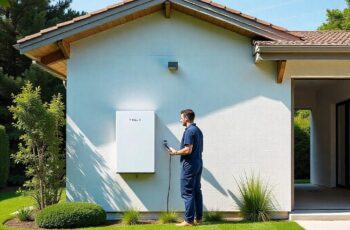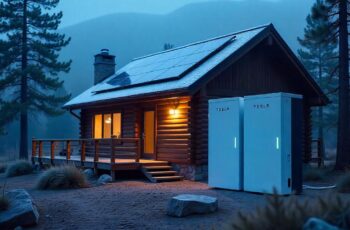Thinking about installing a Tesla Powerwall to harness solar energy and cut down on utility bills? It’s an exciting step towards sustainable living, but before you dive in, there are some hidden costs you need to know about.
While the Powerwall promises efficiency and savings, overlooking these unexpected expenses could throw off your budget and lead to unpleasant surprises. Imagine confidently making this investment, fully aware of all the potential financial pitfalls. By uncovering these hidden costs now, you’ll be in the driver’s seat, making informed decisions every step of the way.
Ready to discover what you might be missing? Let’s delve into the seven hidden costs of installing a Tesla Powerwall that every savvy homeowner should know.
Initial Purchase Price
Buying a Tesla Powerwall is an investment. The initial cost can be a surprise for many. This expense is often the largest part of the whole process. It includes the device itself and sometimes extra fees. These costs can vary based on location and provider.
Device Cost
The Tesla Powerwall itself has a significant price tag. It is designed for efficiency and durability. This makes it a costly piece of technology. The price reflects its advanced features and storage capacity.
Installation Fees
Installation requires skilled professionals. Their services are not cheap. The complexity of the setup influences the cost. This includes connecting the Powerwall to your electrical system.
Permit Costs
Local authorities often require permits for installation. These permits add to the initial costs. They ensure safety and compliance with regulations. Permit prices vary by region.
Additional Equipment
Additional equipment may be needed for installation. This can include wiring, brackets, or other hardware. These items are crucial for a secure setup. Their cost is separate from the Powerwall.
Shipping Charges
Shipping the Powerwall to your location incurs extra fees. These charges depend on distance and transportation method. They are often overlooked when budgeting.
Taxes
Taxes are another hidden cost. They apply to the purchase and installation. Their rate is determined by local laws. It’s important to consider this expense.
Maintenance Expenses
Though maintenance is not part of the initial cost, it’s crucial. Regular upkeep ensures optimal performance. Maintenance fees can be substantial over time. They should be factored into the total cost.
Installation Expenses
When deciding to install a Tesla Powerwall, the initial price tag often catches your eye. But have you considered the hidden installation expenses that sneak up on you? Beyond the cost of the Powerwall itself, installation expenses can make a significant dent in your budget. Let’s dive into the specifics that you need to keep in mind.
Professional Labor Costs
Getting a Tesla Powerwall up and running isn’t a DIY job. You’ll need professional electricians to install it correctly, and their services don’t come cheap. Depending on your location, labor costs can vary significantly. In urban areas, where demand is higher, you might find yourself paying a premium.
Consider this: a friend of mine thought he could save money by hiring a less experienced electrician. It ended up costing him more due to multiple errors and the need for reinstallation. Always opt for certified professionals to avoid such pitfalls.
Permitting Fees
Did you know that installing a Tesla Powerwall often requires permits? Depending on local regulations, these permits can add unexpected costs to your installation budget. Some regions have strict guidelines, requiring you to obtain specific permits before the installation begins.
In certain areas, these fees can be surprisingly high. A neighbor once shared her experience of having to budget an extra 10% of her installation costs just for permits. Have you checked what permits are necessary in your area? It’s a crucial step that could save you from unforeseen expenses.
What other hidden costs have you encountered when planning your Powerwall installation? Share your experiences in the comments!
Electrical System Upgrades
Installing a Tesla Powerwall can be an exciting upgrade for your home. But be aware of hidden costs that might surprise you. One significant area where expenses can add up is electrical system upgrades. These improvements are essential for safely integrating the Powerwall into your home’s energy setup.
Panel And Wiring Enhancements
Your current electrical panel may not support the Powerwall’s needs. Upgrading to a panel with higher capacity is often required. This ensures the system can handle increased energy flow. Wiring enhancements might also be necessary. Older homes with outdated wiring pose risks. New wiring helps manage the Powerwall’s power efficiently. Electrical work can be costly, so budget for these changes.
Additional Equipment Needs
Installing a Powerwall might require more than just the unit itself. Additional equipment can include circuit breakers and disconnect switches. These devices are crucial for safety and proper operation. Surge protectors may also be needed to guard against electrical spikes. Equipment costs can vary widely. Consider consulting an electrician for a detailed assessment. This helps identify specific needs for your setup.
Maintenance And Servicing
When considering the installation of a Tesla Powerwall, it’s easy to get excited about the promise of sustainable energy and lower electricity bills. However, it’s important to remember that maintaining your Powerwall comes with its own set of challenges and costs. Regular maintenance and potential servicing are often overlooked but crucial aspects that could impact your overall investment.
Routine Check-ups
Like any other high-tech device, your Tesla Powerwall requires routine check-ups to ensure it operates efficiently. While the initial installation might be straightforward, keeping it in top condition demands regular inspections. Are you prepared to schedule these check-ups and potentially pay for them out of pocket?
Routine maintenance often involves checking the battery’s health, software updates, and ensuring all connections are secure. Even if you’re tech-savvy, hiring a professional can offer peace of mind, albeit at a cost. These check-ups might seem minor, but they play a crucial role in prolonging the lifespan of your Powerwall.
Potential Repair Costs
No one likes to think about things breaking down, but potential repair costs are a reality with any electronic device. The Tesla Powerwall is no exception. If something goes wrong, are you financially prepared to handle the repairs?
While Tesla offers a warranty, it’s essential to read the fine print to understand what is covered. Repairs that fall outside the warranty can be expensive. Understanding these costs upfront can help you make an informed decision about whether a Powerwall is right for your home.
Consider if you have a contingency plan for unexpected repairs. Would you be comfortable with the added expense, or would it strain your budget? Being proactive about these questions can save you stress in the long run.
Incorporating maintenance and potential repair costs into your budget might seem daunting, but it’s a necessary step in your journey towards sustainable living. Have you factored these hidden costs into your overall investment strategy? Taking the time to address these aspects now can prevent unpleasant surprises later.
Battery Efficiency Loss
Installing a Tesla Powerwall offers significant benefits. Yet, battery efficiency loss is a hidden cost worth noting. As batteries age, their ability to hold charge decreases. This impacts the overall performance of the Powerwall system. Understanding these changes helps in managing expectations.
Diminishing Capacity
Over time, the Powerwall’s capacity reduces. This means it holds less energy than before. The initial performance may be high, but gradual decline is inevitable. Regular usage and charging cycles contribute to this loss. Proper maintenance can slow down this process. Yet, the loss of capacity cannot be avoided entirely.
Replacement Timing
Knowing when to replace your Powerwall is crucial. As battery efficiency drops, replacement becomes necessary. Manufacturers provide lifespan estimates, yet real-world usage varies. Monitoring performance helps in deciding the right time for replacement. Planning for replacement cost is wise. It ensures the system continues to meet energy needs.
Impact On Home Insurance
Installing a Tesla Powerwall may seem straightforward. But, it affects your home insurance. Many homeowners overlook this aspect. Insurance policies consider new installations. This includes home energy systems. Understanding these impacts can save future headaches.
Before installing a Powerwall, review your insurance policy. Ensure you know potential changes in coverage or costs. This section highlights important points about insurance adjustments and premium impacts.
Policy Adjustments
Home energy systems often need policy updates. Your insurer may require new coverage terms. Some policies might have exclusions. These can affect your Powerwall coverage. Contact your insurer to discuss these changes. Neglecting this step can lead to denied claims.
Premium Increases
Adding a Powerwall could raise your premium. Insurers assess risks with new installations. This evaluation might lead to higher costs. Discuss potential increases with your agent. Understanding these costs helps in budget planning. Always factor them into your decision.
Resale And Depreciation
Installing a Tesla Powerwall can be an exciting decision. But understanding its potential resale value is crucial. Like any technological investment, the Powerwall may depreciate over time. This can affect its worth if you decide to sell your home. Let’s explore two key aspects: market value fluctuations and long-term investment concerns.
Market Value Fluctuations
The market for home energy solutions is still evolving. New advancements can impact the value of older systems. A Powerwall installed today might not hold its value in five years. Buyers often seek the latest technology. This can make older models less appealing. Market trends also play a role. Economic factors can influence demand for energy storage solutions. This can cause price variations.
Long-term Investment Concerns
Considering the long-term value of a Powerwall is important. Some homeowners see it as an investment. But the return isn’t always guaranteed. The system’s efficiency may decline over time. Maintenance costs can add up, affecting overall savings. If the Powerwall depreciates faster than expected, it may not provide the financial benefits anticipated. Weighing these potential costs against the savings is essential.
Frequently Asked Questions
How Much Does Installing A Tesla Powerwall Cost?
Installing a Tesla Powerwall typically costs between $7,000 and $10,000. Prices vary based on installation complexity. This cost includes the hardware and labor. Local incentives or rebates might reduce expenses. Contact a certified installer for an accurate quote tailored to your home needs.
Are Tesla Powerwalls Tax Deductible?
Tesla Powerwalls may qualify for tax deductions through the federal solar tax credit. Eligibility depends on installation and purchase specifics. Consult a tax professional for personalized advice. Ensure compliance with local and federal regulations.
How Long Until Powerwall Pays For Itself?
Powerwall typically pays for itself in 6 to 12 years. Savings depend on electricity costs and usage. Efficient energy management speeds up the payback period. Consider installation costs and local incentives for accurate calculations. Investing in solar panels alongside Powerwall enhances savings and reduces payback time.
What Is The Payback Period Of A Tesla Powerwall?
The payback period for a Tesla Powerwall typically ranges from 5 to 10 years. It depends on local electricity costs, incentives, and individual energy usage patterns. Proper installation and optimal usage can shorten this period, making it a worthwhile investment for many homeowners seeking energy savings and independence.
Conclusion
Understanding Tesla Powerwall costs can help avoid surprises. Assess each hidden expense carefully. Factor installation fees and extra equipment. Consider maintenance and insurance costs too. Energy savings may offset these, but not always. Evaluate your budget before proceeding. Consult professionals for accurate estimates.
Prepare for possible future upgrades. Research thoroughly to prevent unexpected financial burdens. Wise planning ensures smooth integration into your energy system. Make informed decisions and enjoy reliable power.

